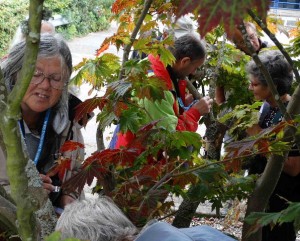Whiteknights is an amazing teaching resource. Recently I led a lichen ‘walk’ for the Reading District Natural History Society from the car-park in front of the Harborne Building. I’ve put ‘walk’ in inverted commas because we really didn’t walk very far.
Starting with a red-leaved Acer in one corner of the car-park we explored crustose and foliose lichens and examined the curb-stones at the edge of the tarmac. Then we looked at the roadside trees behind the Engineering Building, seeing how the availability of rain water affects lichen distribution. Large foliose lichens were common in branch axils where water accumulates before draining down the trunk, while only leprose lichens survived in the rain-shadows below large branches.
A near-by wall gave us the chance to see how different lichen species prefer either the acidic surface of the bricks or the basic, and more porous, mortar.
We examined nitrogen-enriched lichen communities on painted window sills and looked at the orange smudges of Trentepohlia, a free-living green alga, that we found on bark. We even spotted a coral pink licheniclous fungus, Marcandiomyces corallinus.
Going in the opposite direction we looked on soil behind the greenhouses and admired the tiny colonies of the gelatinous lichen Collema tenax. Unfortunately I forgot to show everyone the free-living cyanobacteria Nostoc that occurs in the next bed. But we did stop to admire some thalli of a Peltigera species and also the similarly shaped thalli of Marchantia polymorpha, a thalloid liverwort.
All this diversity lies within 200 metres of car-park 13!



Nice, I took a few members of my choir on a similar lichen “walk” a while back. We didn’t get far either! Lecanora muralis on the concrete bench outside Palmer was my favourite! Dr M